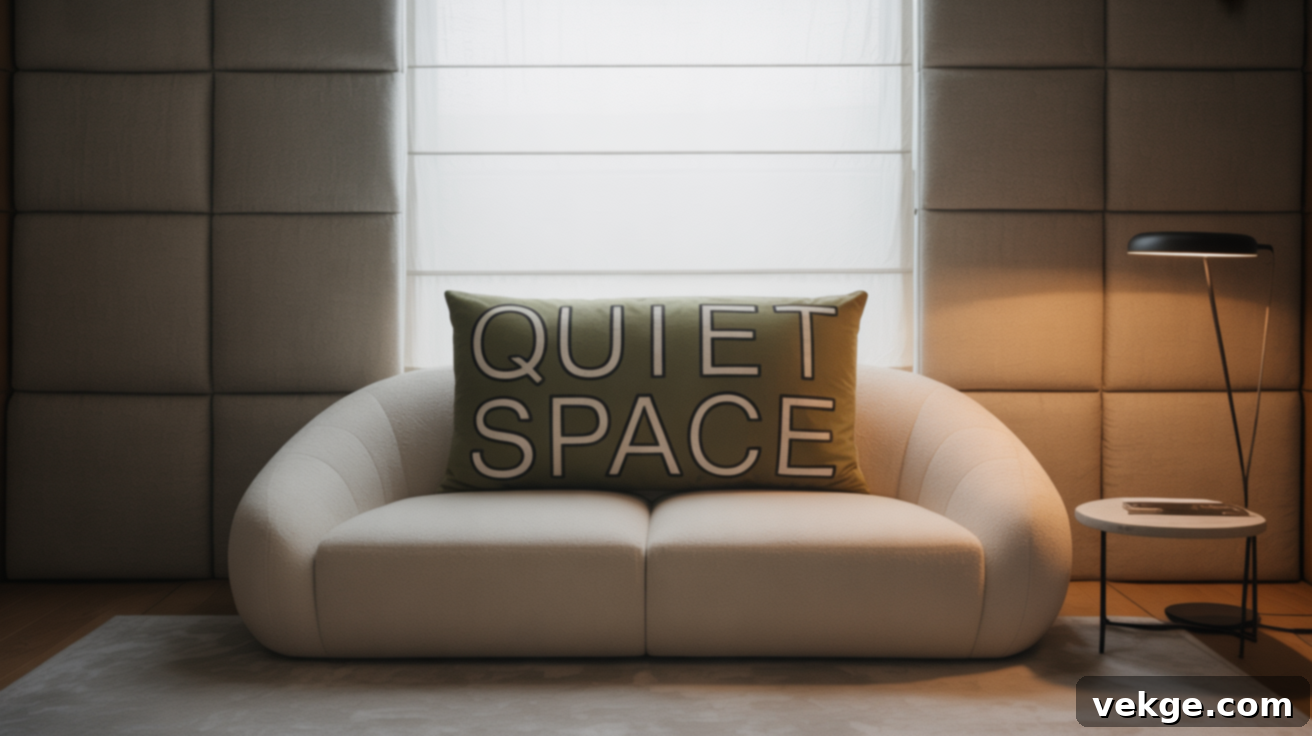Achieve Tranquility: Renter-Friendly Soundproofing Solutions for a Peaceful Apartment
Living in a rental property often comes with an unspoken agreement: a symphony of sounds that can range from mildly annoying to downright disruptive. Whether it’s the rhythmic thud of footsteps from your upstairs neighbor, the incessant hum of city traffic outside your window, or perhaps a pet’s late-night serenades from next door, external noises can quickly erode your peace of mind. Many renters find themselves resorting to desperate measures, like piling extra pillows over their ears or cranking up the TV volume, just to escape the sonic intrusions. You’re certainly not alone if you’ve dreamt of a quieter sanctuary.
The idea of soundproofing might conjure images of elaborate renovations, complete with demolition and construction. However, achieving a more serene living space doesn’t require such drastic (or expensive) measures. There are numerous simple, effective, and renter-friendly strategies you can employ to significantly reduce unwanted noise. Whether you’re one of the growing number of people working from home and need an environment conducive to focus, or simply desire a greater sense of calm throughout your day, these solutions can help. Crucially, they allow you to achieve a quieter home without jeopardizing your security deposit. With these considerations in mind, let’s explore practical, impactful ways to transform your rental into a peaceful haven.
The Essential Role of a Quiet Living Space in Rentals
In today’s fast-paced world, a quiet living space isn’t merely a luxury; it’s a fundamental necessity, especially for individuals residing in rental properties or shared living environments. For countless people, home serves as a vital sanctuary – a place to unwind, recharge, and escape the stresses of the outside world after a long day. However, a constant barrage of noise, whether from boisterous neighbors, persistent street traffic, or hallway chatter, can severely undermine this essential respite. Such intrusions can compromise everything from the quality of your sleep and your ability to relax to your cognitive flow and overall mental well-being. Living in shared buildings often means relinquishing some control over your immediate environment, which can sometimes feel unsettling or even anxiety-inducing.
This reality underscores the paramount importance of cultivating a quieter home. It transcends mere comfort, directly impacting your health and overall quality of life. A calm and tranquil space fosters clarity of thought, reduces stress levels, and allows you to feel truly comfortable and secure within your own four walls. For those who work remotely, study, or engage in creative pursuits, the ability to concentrate without constant distraction is non-negotiable for productivity and success. In rental situations, where structural modifications are typically forbidden, finding creative, non-invasive methods to mitigate noise becomes even more critical. Engaging with a knowledgeable local Texas property manager can be a wise first step, as they might offer insights into renter-friendly noise reduction techniques that align with your lease agreement and property guidelines.
Prioritize Communication with Your Property Manager Before Making Changes

Ensure Lease Compliance
Regardless of how minor a modification might seem, it is always a best practice, and often a contractual requirement, to consult your property manager before making any alterations or improvements to your apartment. This includes seemingly innocuous changes aimed at noise reduction, such as installing temporary door sweeps or hanging heavy curtains. Your lease agreement contains specific language outlining what is permissible and what constitutes a breach of contract, particularly regarding physical modifications to the property. What might be acceptable in one rental unit or building could be strictly prohibited in another. For instance, while Command Strips are generally considered renter-friendly, some leases may even restrict their use if they leave residue or peel paint. Drilling holes in walls, even for small hooks, almost universally requires prior approval.
Proactive communication with your property manager is a smart and essential step. It helps you avoid unexpected fees or deductions from your security deposit that could arise from unauthorized changes. Furthermore, initiating this conversation demonstrates respect for the property and the terms of the lease you signed. Many property managers are often amenable to reasonable unit upgrades, especially if they are reversible, non-damaging, and potentially enhance the unit’s appeal for future tenants. When in doubt, a quick text or email to clarify can save you significant headaches and expenses down the line. Your chances of receiving approval for minor, reversible changes are significantly higher when you ask for permission beforehand, rather than facing a costly surprise upon move-out.
Avoid Costly Deposit Deductions
It’s incredibly easy to get carried away with DIY solutions, especially when you’re desperate to silence persistent noise in your rental. However, in a leased property, even the smallest change can have significant consequences if it violates the terms of your lease agreement. Actions like hanging heavy curtains with hardware that requires drilling, applying adhesive sound panels directly to walls, or using strong tapes that can damage paint or wallpaper can all lead to unforeseen deductions from your security deposit when you move out. This is precisely why it’s crucial to involve your property manager early in your soundproofing plans.
A simple email or message outlining your proposed changes, particularly those involving non-damaging materials, can save you considerable time, money, and stress in the long run. Often, property managers are quite willing to approve small, reversible modifications, provided they don’t cause permanent damage to the walls, floors, or fixtures. They might even be able to offer valuable insights based on their experience with previous tenants or suggest landlord-approved methods for noise reduction. At the very least, seeking their input demonstrates your respect for the property and helps to prevent future problems or misunderstandings. While the original content mentioned documenting violations of quiet enjoyment, it’s equally vital to document your communications and any approved modifications with your property manager. Keeping everyone on the same page from the outset significantly increases your chances of retrieving your full security deposit and, more importantly, enjoying a peaceful night’s sleep free from worry.
Landlord-Approved Ways to Soundproof Your Apartment
Utilize Non-Damaging Materials
When embarking on a soundproofing project in a rental, your primary objective should be to employ materials and methods that leave no discernible signs of damage to the property. Since landlords typically prohibit actions like ripping up existing carpeting or drilling permanent holes into walls, your best bet lies in identifying temporary, easily removable, or entirely damage-free noise-reduction options. Seek out acoustic panels that feature self-adhesive backing designed to peel off cleanly, fabric wall hangings (like tapestries or thick blankets), door draft dodgers, and area rugs. Another highly effective and completely non-damaging strategy is to strategically rearrange your furniture. By positioning large, upholstered pieces or filled bookshelves against shared walls, you can significantly reduce sound transmission without altering any structural elements.
Beyond furniture, heavy curtains – particularly blackout or thermal varieties – are excellent for blocking both light and external sound. These simple, temporary adjustments can dramatically alter the acoustic environment of your apartment, making it feel much more serene, all while safeguarding your security deposit. The overarching goal is to effectively minimize noise, adhere strictly to your lease terms, and maintain a comfortable, homely atmosphere. By carefully selecting the right materials and applying these creative strategies, you won’t have to compromise on either peace or compliance.
Focus on Windows and Doors
Windows and doors are often the most significant culprits when it comes to unwanted noise infiltrating your apartment. Gaps around frames, thin windowpanes, and hollow-core doors act as direct conduits for external sounds. Fortunately, these are also areas where you can make substantial improvements with renter-friendly solutions. A simple yet effective step is to apply self-adhesive weatherstripping tape to the small gaps surrounding your door and window frames. This creates a tighter seal, blocking both sound waves and drafts.
For windows, installing thick, noise-reducing curtains offers a multitude of advantages. While they won’t entirely eliminate all sound, they will provide a noticeable improvement, especially if you live on a busy street or near other noise sources. Look for curtains made from dense, heavy fabrics like velvet or thermal materials, and ensure they extend beyond the window frame and reach the floor for maximum effect. For doors, placing draft stoppers or “door snakes” at the base effectively blocks sound and cold air from seeping underneath. Many stylish and affordable options are available. If you have older windows that rattle or don’t close securely, it’s definitely worth discussing this with your property manager. They may be willing to address these issues as part of regular maintenance, potentially leading to a more permanent noise reduction solution. While these minor alterations might not completely soundproof your apartment, they will undoubtedly contribute to a significant reduction in noise, providing you with a greater sense of quiet without causing any trouble with your landlord.
Utilize Furniture and Textiles to Absorb Sound
Sometimes, the most effective soundproofing tools are already within your living space. Furniture doesn’t just fill a room; it can also play a crucial role in blocking, absorbing, and diffusing noise. The strategic placement of various household items can significantly impact your apartment’s acoustics. For instance, if you have a bookshelf positioned against a wall shared with a noisy neighbor, filling it with books acts as an excellent sound barrier. The denser the bookshelf and the more books it contains, the greater its ability to absorb sound waves and prevent them from traveling through the wall.
Beyond bookshelves, consider the power of upholstered furniture. Hardwood floors, while aesthetically pleasing, tend to amplify sound and create echoes. Introducing a large, thick area rug with a quality rug pad can drastically absorb impact noise and reduce reverberation. Similarly, upholstered sofas, armchairs, and ottomans made from fabric materials are far superior at absorbing sound compared to their leather or solid wood counterparts. By adding more soft surfaces, such as a plush couch, an abundance of decorative pillows, or fabric wall hangings like tapestries, you effectively increase the amount of sound-absorbing material in your apartment. Think of it as intentionally “softening” your apartment with textiles and furnishings to create a buffer against both internal echoes and external noise. Even strategically placed large wardrobes, especially if filled with clothes, can act as excellent sound dampeners against shared walls, providing a dense barrier that helps to muffle unwanted sounds.
Conclusion
Finding a quiet sanctuary within a bustling rental property is a highly valued aspect of comfortable living. Even if you’re not in a position to undertake major renovations, you are by no means condemned to endure constant noise filtering through your walls. With a bit of creativity, thoughtful planning, and renter-friendly strategies, there are always effective ways to minimize unwanted sound. The best part is that you don’t have to risk damaging your space or worry about forfeiting your security deposit in the process.
Small changes, when implemented strategically, can make a significant difference. Whether it’s as straightforward as repositioning your existing furniture, hanging dense curtains, or exploring the many other ingenious solutions discussed, achieving a more peaceful home environment is well within your reach. Ultimately, everyone deserves to feel calm, comfortable, and at ease in their own home, and with these practical soundproofing tips, you can transform your rental into the tranquil haven you’ve always desired.
